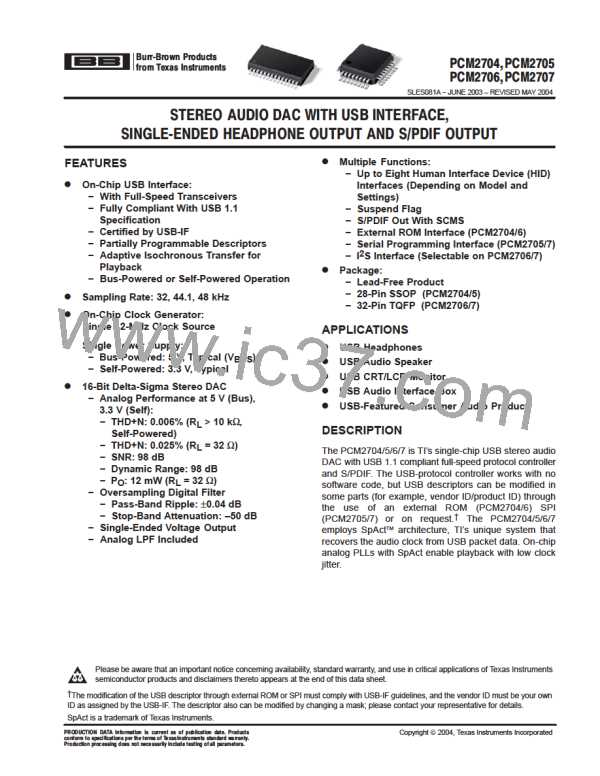ꢀ ꢁꢂ ꢃ ꢄ ꢅ ꢆꢇ ꢀꢁ ꢂ ꢃ ꢄ ꢅ ꢈ
ꢂ
ꢀ
ꢁ
ꢂ
ꢃ
ꢄ
ꢅ
ꢉꢇ
ꢀ
ꢁ
ꢃ
ꢄ
ꢅ
ꢄ
www.ti.com
SLES081A − JUNE 2003 – REVISED MAY 2004
Interface #1 (Isochronous-Out Interface)
Interface #1 is for the audio-streaming data-out interface. Interface #1 has the following three alternative settings.
Alternative setting #0 is the zero-bandwidth setting. All other alternative settings are operational settings.
ALTERNATIVE
SETTING
TRANSFER
MODE
SAMPLING RATE
(kHz)
DATA FORMAT
00
01
02
Zero bandwidth
2s complement (PCM)
2s complement (PCM)
16-bit
16-bit
stereo
mono
Adaptive
Adaptive
32, 44.1, 48
32, 44.1, 48
Interface #2 (HID Interface)
Interface #2 is the interrupt-data-in interface. Interface #2 comprises the HID consumer control device. Alternative
setting #0 is the only possible setting for interface #2.
On the HID device descriptor, eight HID items are reported as follows for any model, in any configuration.
Basic HID operation
Interface #2 can report the following three key statuses for any model. These statuses can be set by the HID0–HID2
pins (PCM2704/6) or the SPI port (PCM2705/7).
D
D
D
Mute (0xE2)
Volume up (0xE9)
Volume down (0xEA)
Extended HID operation (PCM2705/6/7)
By using the FUNC0–FUNC3 pins (PCM2706) or the SPI port (PCM2705/7), the following additional conditions can
be reported to the host.
D
D
D
D
Play/Pause (0xCD)
Stop (0xB7)
Previous (0xB6)
Next (0xB5)
Auxiliary HID status report (PCM2705/7)
One additional HID status can be reported to the host though the SPI port. This status flag is defined by SPI command
or external ROM. This definition must be described as on the report descriptor with a three-byte usage ID. AL A/V
Capture (0x0193) is assigned as the default for this status flag.
Endpoints
The PCM2704/5/6/7 has three endpoints as follows.
D
D
D
Control endpoint (EP #0)
Isochronous-out audio data-stream endpoint (EP #2)
HID endpoint (EP #5)
The control endpoint is a default endpoint. The control endpoint is used to control all functions of the PCM2704/5/6/7
by standard USB request and USB audio-class-specific request from the host. The isochronous-out audio data
stream endpoint is an audio sink endpoint, which receives the PCM audio data. The isochronous-out audio data
stream endpoint accepts the adaptive transfer mode. The HID endpoint is an interrupt-in endpoint. The HID endpoint
reports HID status every 10 ms.
The HID endpoint is defined as a consumer control device. The HID function is designed as an independent endpoint
from the isochronous-out endpoint. This means that the effect of HID operation depends on host software. Typically,
the HID function is used to control the primary audio-out device.
18

 TI [ TEXAS INSTRUMENTS ]
TI [ TEXAS INSTRUMENTS ]